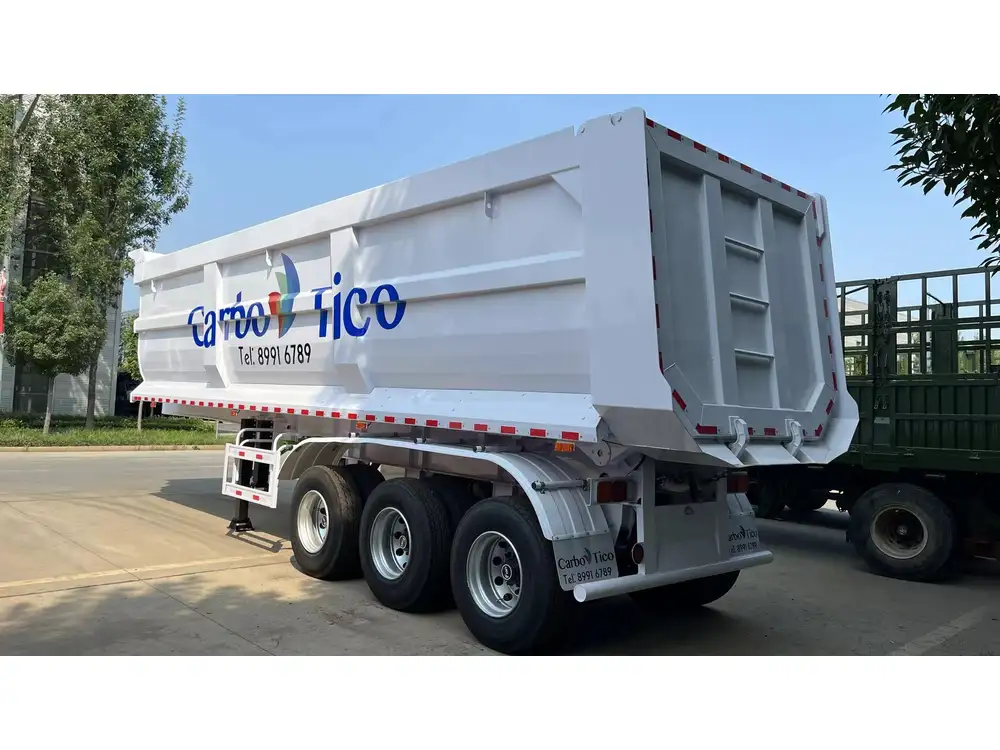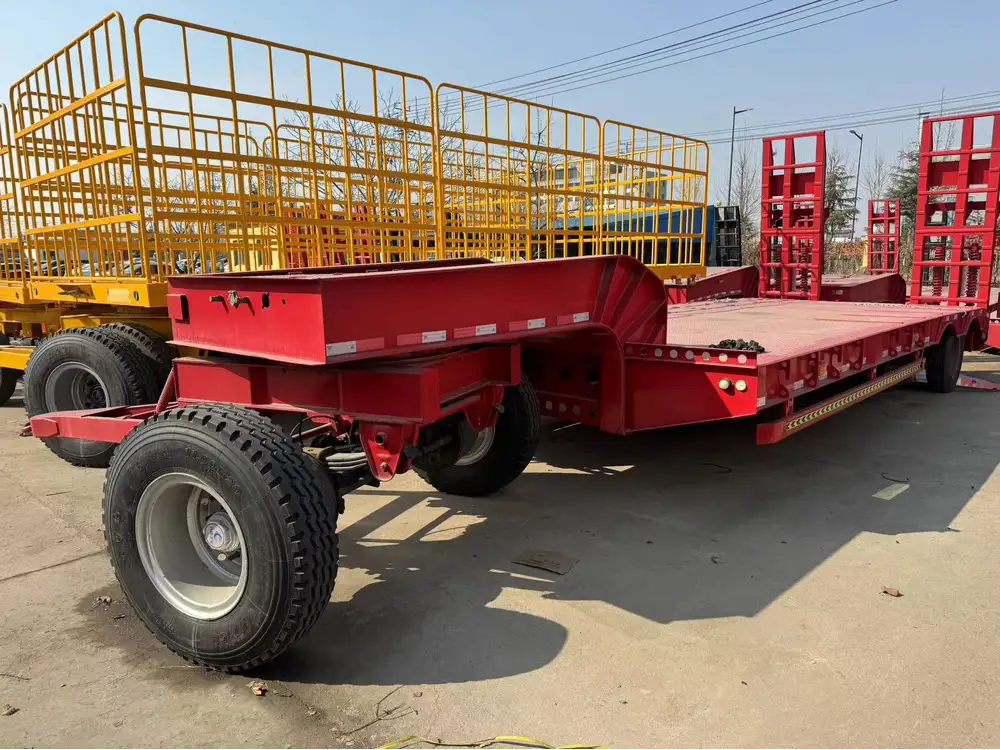In the logistics and transportation industry, the size of a semi-trailer is a fundamental aspect that impacts everything from cargo capacity to compliance with regulations. Accurately understanding these dimensions can significantly affect operational efficiency, cost management, and overall safety on the road. This article will dissect the various sizes of standard semi-trailers, typical configurations, and the factors influencing their dimensions.
1. Definition of a Semi-Trailer
A semi-trailer is a type of trailer that relies on a tractor unit for support, with the front part resting on the fifth wheel coupling of the tractor. Unlike full trailers, semi-trailers do not have a front axle but rather a design that allows them to pivot easily while on the road.
2. Standard Dimensions of Semi-Trailers
Understanding the size of a semi-trailer involves more than just length; it encapsulates width, height, and weight capacity. Here, we will explore the typical dimensions across various types of semi-trailers:

2.1 Length
- Standard Length: The legal maximum length for most semi-trailers is 53 feet (16.15 meters) for freight transportation in the United States, although lengths can vary by region and according to specific state regulations.
- Common Lengths: Most semi-trailers come in lengths of 28, 48, and 53 feet, with 53-foot trailers being the most prevalent in the logistics sector, thanks to an ideal balance between capacity and maneuverability.
2.2 Width
- Standard Width: The common width for semi-trailers is 102 inches (8.5 feet or 2.59 meters), which is permitted under federal regulations in the U.S.
- Specialized Trailers: Some specialized trailers, like those intended for transporting oversized loads, might exceed this width, reaching up to 120 inches (10 feet or 3.05 meters), but often require permits.
2.3 Height
- Standard Height: The typical height of a semi-trailer can range from 13.5 feet (4.1 meters). It’s crucial to monitor clearances when transporting goods, as local structures may limit the height for safe passage.
- Low-Profile Designs: Certain trailers are designed to have lower profiles, around 12.5 feet (3.81 meters), allowing for transportation under low bridges without exceeding legal height restrictions.

2.4 Weight Capacity
- Gross Vehicle Weight Rating (GVWR): Most semi-trailers carry a GVWR ranging from 34,000 to 80,000 pounds (15,422 to 36,287 kg), depending on the configuration and number of axles. This weight includes the trailer itself and its cargo.
3. Common Types of Semi-Trailers and Their Sizes
3.1 Dry Van Trailers
- Dimensions: Typically 48 to 53 feet long, 102 inches wide, and can accommodate over 45,000 pounds of cargo.
- Ideal Use: Perfect for general freight that requires protection from weather and road conditions.

3.2 Flatbed Trailers
- Dimensions: Generally 48 feet long and 102 inches wide; load capacity can reach up to 48,000 pounds.
- Versatility: Suitable for hauling machinery, lumber, and other expansive items that don’t fit within the confines of a closed trailer.
3.3 Refrigerated Trailers (Reefers)
- Dimensions: Commonly 53 feet long; width similar to standard trailers, typically 102 inches.
- Special Features: Equipped with cooling units, these trailers are essential for transporting perishable goods.
3.4 Tank Trailers
- Dimensions: Varies widely based on volume, commonly between 36 and 48 feet in length.
- Specific Use: Designed to carry liquids; their size and shape are critical for maintaining the integrity of transported substances.

3.5 Dump Trailers
- Dimensions: Usually 14 to 35 feet long; width can range up to 102 inches.
- Functionality: Primarily used for transporting sand, gravel, or demolition waste, emphasizing load-dumping capabilities.
4. Legal and Regulatory Considerations
4.1 Federal Regulations
While the above dimensions serve as standards, federal laws regulate the physical limitations imposed on semi-trailers, primarily stipulated by the Federal Motor Carrier Safety Administration (FMCSA).
- Length Limits: Most states adhere to the 53-foot maximum for semi-trailers, which can be extended for specialized vehicles with the proper permits.
- Width Restrictions: The 102-inch limit helps ensure safety on the roads and is a widely-accepted standard across most states.

4.2 State Regulations
Different states may have unique regulations regarding semi-trailer sizes, so it’s crucial for transporters to familiarize themselves with local laws. Some states might have restrictions that are more stringent than federal guidelines, particularly concerning weight limits.
5. Factors Influencing Semi-Trailer Size Selection
5.1 Type of Cargo
The nature of the cargo heavily dictates the type of semi-trailer used. For instance, oversized items necessitate flatbed trailers, while temperature-sensitive products require refrigerated units.

5.2 Route Characteristics
Understanding the route is vital. Areas with height restrictions or narrow roads can exclude certain trailer types from consideration, leading companies to favor smaller or specialized trailers.
5.3 Weight Regulations
Different states enforce various maximum weight regulations, impacting the choice of trailer selected. Companies must calculate the GVWR for compliance, ensuring that their configurations meet or fall below limits based on cargo.
5.4 Cost Efficiency
Operational costs are also a significant determinant. Larger trailers may carry more products, resulting in fewer trips, but could incur higher fees in tolls or fuel consumption. Transport companies must evaluate trade-offs carefully to determine the most cost-efficient options.

6. Size Comparison Table
| Type of Semi-Trailer | Length (ft) | Width (in) | Height (ft) | Weight Capacity (lbs) |
|---|---|---|---|---|
| Dry Van | 48 – 53 | 102 | 13.5 | 45,000 |
| Flatbed | 48 | 102 | 5 to 6 | 48,000 |
| Refrigerated (Reefer) | 53 | 102 | 13.5 | 45,000 |
| Tank Trailer | 36 – 48 | Varies | 13.5 | 45,000 – 80,000 |
| Dump Trailer | 14 – 35 | 97 – 102 | 5 to 6 | 25,000 – 30,000 |
7. Conclusion
In conclusion, understanding the size of a standard semi-trailer is critical for optimizing logistics operations. With legal height, width, and length limits, along with the specific capacity needs for different types of cargo, industry participants must continually assess their requirements to ensure compliance and efficiency in the transportation sector. By breaking down the dimensions, types, and influencing factors for selecting semi-trailer sizes, companies can make informed choices that enhance productivity and operational effectiveness, while avoiding costly regulatory issues.
This comprehensive exploration not only provides clarity on the sizes of standard semi-trailers but also equips operators with the knowledge necessary for effective decision-making in logistics and transportation—ensuring that they stay ahead in an increasingly competitive marketplace.



